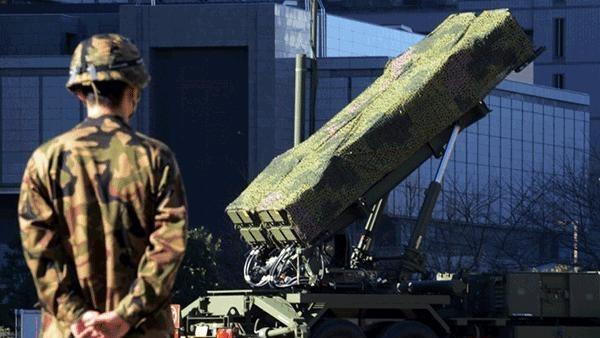 In this Dec 6, 2012 file photo, an officer of the Ground Self-Defense Force (SDF) stands guard near Japan's SDF set Patriot Advanced Capability-3 (PAC-3) missile launcher at the Defence Ministry in Tokyo. (YOSHIKAZU TSUNO / AFP)
In this Dec 6, 2012 file photo, an officer of the Ground Self-Defense Force (SDF) stands guard near Japan's SDF set Patriot Advanced Capability-3 (PAC-3) missile launcher at the Defence Ministry in Tokyo. (YOSHIKAZU TSUNO / AFP)
TOKYO - A ruling party committee on Friday approved a proposal for Japan to acquire capabilities to halt ballistic missile attacks within enemy territory.
The proposals, crafted by senior Liberal Democratic Party lawmakers including former defence minister Itsunori Onodera, will be presented to Prime Minister Shinzo Abe as early as next week
The proposals, crafted by senior Liberal Democratic Party lawmakers including former defence minister Itsunori Onodera, will be presented to Prime Minister Shinzo Abe as early as next week.
Giving long range munitions to Japan’s Self Defence Forces is a controversial issue for a country that renounced the right to wage war after its defeat in World War Two.
ALSO READ: Raytheon 'lobbies for Lockheed's US$300m radar deal' with Japan
“Our country needs to consider ways to strengthen deterrence, including having the capability to halt ballistic missile attacks within the territory of our adversaries,” the proposal document said.
The proposals, crafted by senior Liberal Democratic Party lawmakers including former defence minister Itsunori Onodera, will be presented to Prime Minister Shinzo Abe as early as next week.
The proposal “is to stay within the bounds of the constitution and to comply with international law, that has not changed,” Onodera said at a briefing following policy committee meeting.
The recommendations will be discussed by Japan’s National Security Council, which is expected to finalise new defence policies by the end of September.
ALSO READ: Source: Japan may still build Aegis Ashore missile systems
Abe has pushed for a more muscular military, arguing Japan needs to respond to a deteriorating security environment in East Asia.
A strike option is attractive because it is much easier to hit missiles on launch pads than warheads in travel at several times the speed of sound. Finding mobile launchers to hit, however, require close surveillance with satellites that Japan does not currently possess, meaning it would have to rely on help from ally the United States.
Japan’s defence ministry could decide on equipment purchases by the end of the year, government officials told Reuters.
AEGIS
The ruling party deliberations were prompted by defence minister Kono Taro’s decision in June to cancel two planned Aegis Ashore sites designed to track and target incoming ballistic missiles.
The LDP document included a recommendation that Japan consider how to acquire a defence radar system on a par with Lockheed Martin’s Aegis Ashore system that could also track other threats such as drones and cruise missiles.
Among proposals being considered by officials is locating the Aegis Ashore at other ground sites, or putting the new powerful radar on ships. US defence company Raytheon has been lobbying senior LDP lawmakers with a proposal to choose its SPY-6 radar rather than using Lockheed’s system, sources earlier told Reuters.
READ MORE: Japan gets its 8th defense budget hike, hits US$48.56b
“The government will make a decision regarding this by the end of September and our thinking will be reflected in that,” Onodera said.


